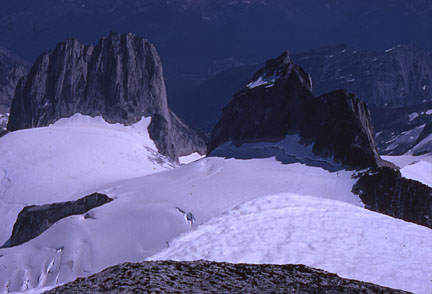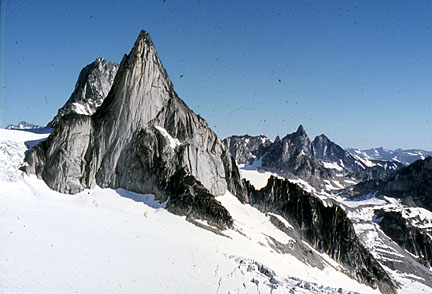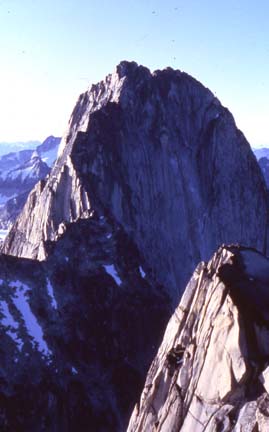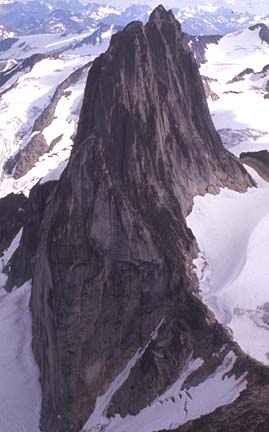-
Posts
12061 -
Joined
-
Last visited
Content Type
Profiles
Forums
Events
Everything posted by mattp
-
I went up there on skis once, and on that occasion we could not drive more than a mile (certainly less than two miles) from the main line. Even then, in March, we made it up to the hut with sufficient daylight left that we were able to take a ski run before dinner. It is an attractive area, and the hut itself is cute, though I didn't see anything truly amazing in the short time that we were up there (we did, as you say, spend most the weekend travelling to and fro). What will you be doing up there?
-
That is a practical solution, Catbird, but I wonder a little bit just how serious the concern is in the first place. We trust bar tacked sewn runners even for the dreaded factor 2 leader fall and, while I realize that the bar tacks between the loops on a daisy are not as strong as th ose on a runner, and I'm sure you'll call up some statistic about how x% of the time they fail at .01KN or something. But the fact is I don't seem to fall of the belay ledge very often (never in 30 years of climbing). If I were to fall off, and fell 12 inches onto my daisy that was clipped what most of us would find uncomfortably long in the first place, how much shock would that generate? And I've caught a lot of falls, but the number times even then that I've put anything like a shock load on the anchors is very small. I belay from my waist so I tend to remember these events. Lastly, I know nobody who stands around on belay anchored only by the daisy. It is always backed up except that folks do it when making multiple rappels - but how could you put a shock load on your teather while standing at a rappel station? Like I said, you've got a good solution to the problem -- and I can think of no reason not to do as you suggest. Maybe I'll even go down in the basement and tie my daisy in a knot right now. I'm just thinking the problem may be slightly overstated.
-
I thought the first generation pumps were the best. If you opened them up too wide they sprayed fuel all over the place but hey: everything has its drawbacks, right? I think these (yellow ones) were BEFORE they started having O'ring problems and they were definitely BEFORE they had the pop-out plunger issue. The original GK stove rocked, too. The Whisperlite seems to do OK as long as you use expensive fuel, but it does seem to foul easily and it is a mess to take it apart and try to clean it in the field. An engine combustion guy once told me that the spreader design is appropriate for preasurized gas, but apparently not for liquid fuel.
-
-
Post deleted by mattp because the cat walking on the keyboard caused distraction, leading to operator error and quip from Dru who was so fast he sprayed before I had time to fix it.
-
I don't think its complicated. If there is one twist or more between the two points of clippage, I believe you are "safe" from that standpoint (though if it is twisted and twisted back again, with the same number of wraps each direction, not). You're doing the right thing by just clipping once, though, because it is a good habit and you don't even have to check it.
-
-
-
For the new Snowpatch forum, here's another shot of that view from the top of Bugaboo toward Snowpatch:
-
Thinker, are you saying this because if you clip two loops of the daisy without a twist between them, the biner will not be clipped in if you rip out all the bar tacks inbetween? Depending on your situation (for example if you may be belaying off the same anchor that you are clipped to via the daisy with maybe a rope back-up as has been suggested above) the advantage of having the tail of the daisy kept out of the way may offset the danger of using the daisy incorretly. Good call on the double-clipping, though -- its something to be aware of.
-
Hood rime ice can be photogenic.
-
Downclimbing the route is a heck of a good option for Goode. Yokum Ridge IS in the second edition of Volume 1.
-
Here's a couple photo's that I have taken on trips that all came about through contacts I've made on cc.com:
-
Lum- My gibbs has no spring. It is not "spring loaded" the way I use that term. You are right that they have no handle on them and this is another reason why they have been largely abandoned in favor of something more like a jumar. So was there a general safety announcement somewhere about how they chop ropes? Aren't jumars and petzl ascender's also thought a poor device for shock loading (though maybe you can tell me they are a little better of an option).
-
I do remember using the Gibs both for self belay on a top rope, and for leading. I never thought it felt all that secure, though, and here again I always backed it up with a real knot. But what do I know -- the way I read this discussion, several of you guys suggest that I am nuts to worry about hitting things during a fall and there is no judgment call involved - I should always set my self belay so as to provide a "dynamic" belay because the dangers of the static catch always exceed those of hitting a ledge (the way I figure it, if I am on a wandering pitch or ridge climb and do as you describe, I may have 10 extra feet of dynamics in the system - and maybe more - before the end of the pitch). I don't remember any widespread announement that the Gibbs ascender was unsafe in any particular announcement, though I suppose there may have been one. My impression is that it just fell out of common usage in pretty much all applications. I believe the fact that it is not spring-loaded, and therefore feels less secure than a jumar, had something to do with this.
-
You don't know his brother. He just eats them.
-
Don't overlook the Washington Regional Weather Loop for a look at where it snowed overnight.
-
I wouldn't say it is necessarily a "bad" idea, but why not use a daisy chain or tie in with the climbing rope instead? I sometimes use one of my shoulder length slings as a personal anchor at a belay ledge or rappel station, and I think it is a good idea to carry a few of these even on a sport climb or where you otherwise don't really plan to use them, but I don't think I'd carry an extra loop of perlon specifically for this purpose. Are you thinking that your loop of perlon may come in handy for a rappel anchor or a prussik sling or something? In my view, you're better off carrying an extra prussik cord on the back of your harness and deliberately NOT using it while on belay so that it may be handy when you want to escape the belay or do something else with it.
-

Goin to lillooet this W/E? dUffy currently closed
mattp replied to Dru's topic in Ice Climbing Forum
Pure speculation on my part, but it looks to me as if the roads will likely reopen by tomorrow morning. Meanwhile, what do you suppose the wave of warm wet weather that caused this avalanche cycle did to the ice climbs? -
Cool. That is not bad for, what, 3,000 feet? I'm pondering having a go at Nason Ridge or something else in the area.
-

[TR] Union Peak- Descent of the NW face 1/25/2004
mattp replied to AlpineK's topic in the *freshiezone*
Eerie, I think you have probably been looking at Lichtenburg. It is that big open mountainside you see on the left, just past the Yodelin ski lodge. That big south slope that you see from the highway can be an excellent powder run sometimes, but you want a good snowpack to fill in all the little trees and for much of the winter, most of the open shots on that side of the mountain have pretty nasty avalanche debris in them. -
I don't mean to be a pain in the neck, but I'm wondering how much snowcover was there in the lower clearcut? 2 feet or 4 feet? How much at the start of the logging road? Is there much "base" at that elevation, or just a few feet of unconsolidated snow?
-
How much snowcover was there in the lower clearcut?






